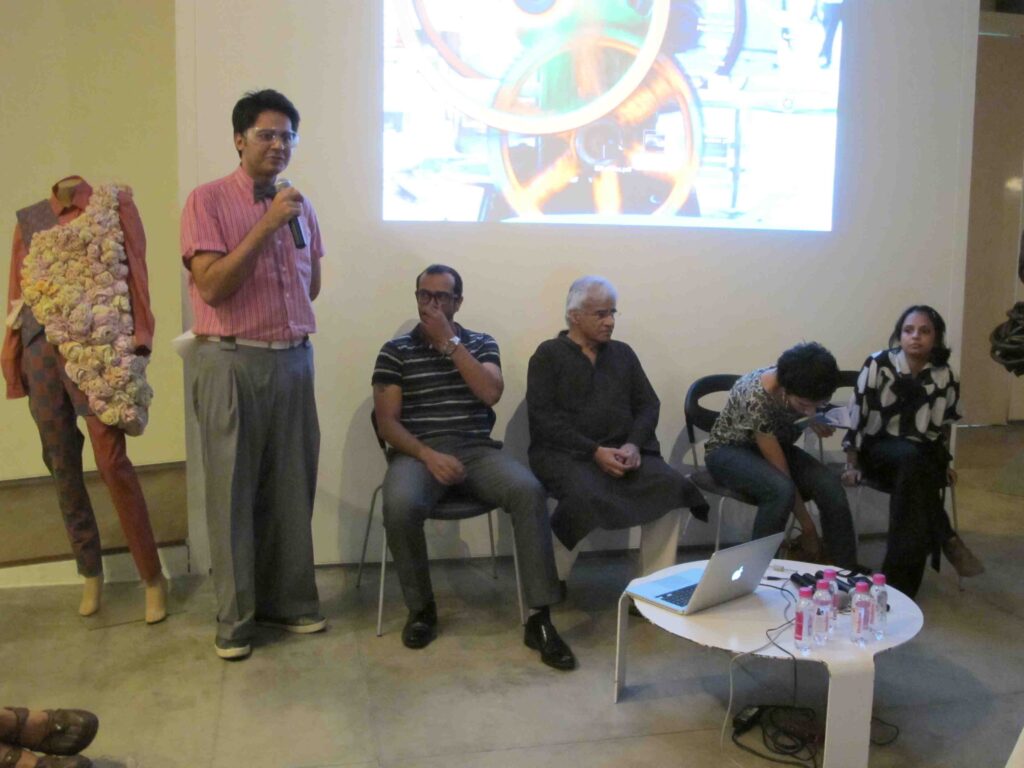I was happy to curate a conversation with Chemould’s Shireen Gandhy on the occasion of the Mumbai exhibition of artist Vivan Sundaram’s latest body of work, Making Strange: Gagawaka. Vivan spent three years in making the sculptural garments exhibited in the show, by utilising everyday and discarded items, like underwear, sanitary napkins, and rubber tubes. Based on the concept of the ready-made or found object, he created these garments as playful, erotic, exaggerated provocations, to question the time of excess and alienation that we live in.
This experiment was probably one of the first in India when someone from the world of art took a step into a deep engagement with fashion, and so, Shireen and I decided to probe this intersection further by curating a discussion around exactly these two themes – art and fashion. From the art world, we had Gitanjali Dang, a curator and critic, someone who knows Vivan’s work well and had modelled his sculptural garments in his Delhi show. From the fashion world, we invited Little Shilpa, who in her work, addresses a lot of what Vivan’s show was about. Recycling, the question of value, memory…. And finally, we put into the mix, Anirban Mukherjee, India’s finest fashion and trends researcher. Through his work over the past few years with Future Brands, he has developed a unique interpretation of the changes among urban, rural, metropolitan and small town India with regards to fashion and identity.
We called the panel Fashion Cycle as a play on both fashion – how it cycles – season after season in the pursuit of newness, and recycling – which is all about deriving value from oldness. I particularly enjoyed seeing images of Shilpa’s work juxtaposed against the mannequins wearing Vivan’s art. Shilpa’s work reflects the larger theme of making strange, as well as recognising the familiar, whether in found objects, or in the other things she works with to create high fashion garments and accessories for clients like Lady Gaga. Very Indian, sometimes kitsch, but also very global. I also enjoyed seeing Anirban’s images of the fashion desires that he was witnessing on the ground, while doing research in small town India. The untucked shirt, the concept of local formal versus MNC formal, and many more, were all ideas he shared with us.
Seeing Vivan’s and Shilpa’s work next to each other made me wonder about the difference between art and design. Weren’t Shilpa’s pieces worthy of being called art? And weren’t Vivan’s sculptures actually design, considering that he executed them with a team from NIFT, after careful planning? Is it just where things are sold that makes a difference? If something is displayed in a shop and sold at a particular price, is it considered a designed product, and if something is displayed in a gallery, then is it art? Or is it the training received by the creator that makes the difference?
I also wondered about how in the West, we have seen a lot of collaborations between fashion and art – right from a Poiret collaborating with printmakers in the early 1900s, to Dali and Chanel, through cubism, art deco, pop art, and so on, and recent collaborations between Louis Vuitton and Murakami or Richard Prince, for instance, or between fashion and music – like the Lady Gaga-Mugler collaboration, or between fashion and architecture – like Zaha Hadid designing mobile Chanel exhibitions. But why don’t we see similar collaborations or intersections in India? Do we need institutional spaces like Cartier Foundation for example, which specifically nurture these kinds of collaborations, or do these need to be organic?
* This post is a modified version of my column Parmesh’s Viewfinder which appears in Verve magazine every month.

